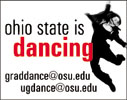



|
Home,
More Advice For Grown-Up Dancers ADVICE FOR GROWN-UP DANCERS 8/30/01: Dancing With the Uncertain Future By Anne
Wennerstrand, CSW, DTR (We want to know what you think! Got a response to Anne's ideas? Or another issue you want to talk about? E-mail anne@danceinsider.com. If your letter is selected, you'll receive a free box of Luna Bars, the whole nutrition bar for women. Men like it too! Special thanks to Clif Bar.) A Grown-Up Dancer writes, "I am a sophomore majoring in dance in a small, Midwestern, liberal arts college (in spite of its size and location it does have a surprisingly good dance department). I have yet to find anything that I am as passionate about as dance, and hope to make at least a short career out of it. Problems arise when I think about the 'what ifs.' What if I never land a job? What if I've wasted four years and thousands of dollars? What if I'll be a waitress the rest of my life? Do you have any wisdom to share that would either guarantee a wonderful career, or at least help me deal with these doubts so I can concentrate on dancing?" I love this dancer's question because so many different issues and concerns are embedded in it. Because the decision to dance is usually made so early in life, deciding to pursue dance professionally often feels more like a passionate calling than a practical life decision. Most dancers describe feeling as if dance chose them rather than they choosing it. This can be very unfamiliar territory for people in the dancer's life (non-dance teachers, counselors, parents), who may be more concerned about the financial practicalities or impracticalities of this life decision. Others in the dancer's life may not be able to readily relate to decisions made based upon passion or from the sheer love of doing something. Yet this is usually what draws the dancer in and provides the fuel to continue dancing against typically enormous obstacles. Dancers contemplating the commitment to professional dance training might benefit from asking themselves if their concerns are solely their own or those of other influential people in their lives. These internalized voices are usually combinations of many people, including ourselves, but they need to be examined, questioned and untangled from our true beliefs about ourselves. Questions may also be reflective of fears and doubts this dancer has about her own abilities which are completely normal. She may be wise to widen the definition of what she feels defines success for her, besides "landing a job." Sometimes the fear she feels can be of "success" itself -- once one has "made it" one can feel enormously overwhelmed as the reality of the life choice of dancing and it's inherent ups and downs become more real. There are many reasons why a young person feels called to dance. The sheer physicality of dance is usually the main reason. People who dance also seem to value a life lived with passion and this must come from their livelihood. The writer describes this need very clearly. Fulfilling her needs and values may translate into a sense of purpose and control or what this writer calls "passion." This passion arises from a very deep source: perhaps an overwhelming desire to express oneself; perhaps enjoying the feeling of dancing and discovering that she is good at it makes her feel vibrant, alive and valued by others. Some pursue a career in dance as a way to gain recognition, to stand out and to feel special. This can be to compensate for a deeper or nagging sense that without dance one would lose one's specialness. Inner necessity or personal pain can be motivating factors. A desire to be in control through doing something which is clearly defined and where the expectations and authority structures are very clear (as in a ballet class) is one way individuals cope with a lack of inner security. In some cases, dance becomes more important than people and relationships and in this case dance is almost always an escape into "doing" for someone who cannot tolerate simply "being." In Eric Maisel's excellent book, "A Life in the Arts," the author states that people are most artistically creative and successful when they "love what they are doing, know what they are doing, and actively engage in the tasks we call art-making. The three elements of creativity are thus loving, knowing and doing; or heart, mind and hands; or, as Buddhist teaching has it, great faith, great question, and great courage." (p.7). Knowing what we are doing and actively engaging in the activities of dancing and dance-making in a supportive environment can soothe some of the inevitable uncertainty that goes along with this life choice. College dance students can be particularly concerned with whether their "investment" in dance will pay off in terms of reaching their perceived goals. It is important to remain fluid in terms of one's goals in the dance profession (and in any profession), to be careful not to define success so narrowly that only one outcome (getting into a dance company or a show) would mean success. Being creative with alternative models to the traditional ones can help, as can remaining curious about your future options as opposed to only fearful about them. Speaking of leaping into the uncertain future and keeping fear in check, I'll be on maternity leave the next few months but still available via email. Please keep suggestions for future columns coming! Anne Wennerstrand has a private psychotherapy practice in New York City and is available for individual, group and organizational consultation. To read more about Anne, please visit the "Contact Us" page.
|
